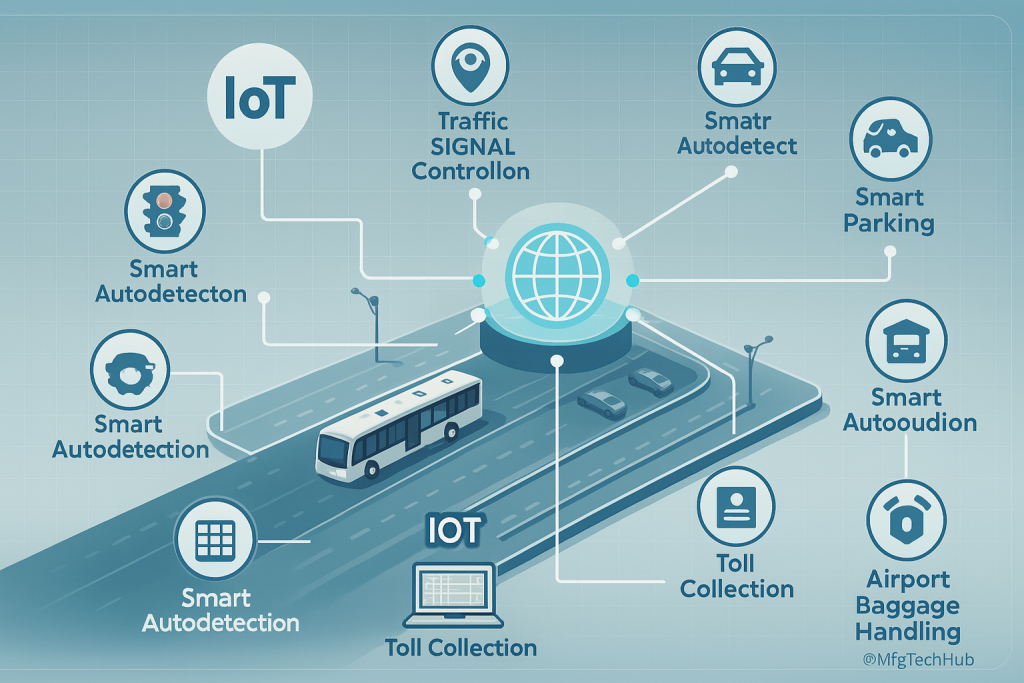PLC Applications in Transportation Systems
Transportation systems worldwide rely on automation and intelligent control to ensure efficiency, safety, and reliability. Programmable Logic Controllers (PLCs) play a crucial role in managing and optimizing various transportation infrastructures, including traffic signals, automated train systems, toll collection, and airport baggage handling. These systems require real-time decision-making, remote monitoring, and integration with smart networks, all of which PLCs facilitate.

This page explores how PLCs revolutionize transportation, key applications, real-world examples, and future trends in smart mobility.
1. The Role of PLCs in Transportation
Transportation automation is essential for reducing delays, enhancing safety, and improving overall efficiency. PLCs are widely used in urban mobility, logistics, and critical transportation infrastructures such as:
- Traffic Control Systems – Managing traffic signals and vehicle flow
- Railway Automation – Controlling train speeds, signaling, and safety mechanisms
- Toll Collection – Automating toll booths for faster payment processing
- Airport Systems – Handling baggage movement and security screening
- Elevators & Escalators – Ensuring smooth passenger movement in stations and airports
Example: A smart city integrates PLC-controlled adaptive traffic signals, adjusting light timings based on real-time traffic density to reduce congestion.
2. Key Applications of PLCs in Transportation
A. Traffic Signal Control Systems
PLCs optimize traffic lights at intersections, ensuring smooth traffic flow, reducing congestion, and prioritizing emergency vehicles.
PLC-Controlled Traffic Management Features:
- Real-time signal adjustments based on traffic conditions
- Synchronization of multiple intersections
- Integration with pedestrian and emergency vehicle systems
Example: In Tokyo, PLC-controlled smart traffic lights dynamically adjust timings based on sensor-detected congestion, reducing delays during peak hours.
B. Railway & Metro Train Automation
PLCs control railway signals, train speeds, braking systems, and automatic doors, ensuring passenger safety and operational efficiency.
How PLCs Improve Railway Systems:
- Automated Train Control – Managing train movements with precision
- Real-Time Monitoring – Tracking train speed, doors, and passenger load
- Safety Mechanisms – Emergency braking and collision avoidance
Example: The London Underground uses PLC-controlled automation to manage train schedules, reduce delays, and improve passenger experience.
C. Toll Collection and Smart Highways
PLCs play a crucial role in automated toll booths, ensuring seamless and contactless toll collection for faster highway movement.
PLC-Based Toll Management Features:
- Automatic vehicle detection using RFID & sensors
- Instant payment processing through smart tags & ETC
- Traffic gate control for toll booths and highways
Example: India’s FASTag system uses PLC-controlled RFID-based toll collection, reducing queue times and improving highway traffic flow.
D. Airport Baggage Handling Systems
PLCs ensure smooth, accurate, and secure baggage movement, optimizing airport logistics and security screening.
PLC-Controlled Baggage Handling Functions:
- Sorting and routing baggage automatically to flights
- Real-time tracking and scanning for security checks
- Minimizing luggage misplacements through automated conveyor systems
Example: Dubai International Airport uses PLC-integrated systems to process up to 16,000 bags per hour, ensuring efficient and secure transfer.
E. Automated Parking & Vehicle Management
Modern parking facilities use PLC-controlled systems for automated entry, exit, and vehicle tracking.
PLC-Based Smart Parking Features:
- License plate recognition and automatic gates
- Smart sensors to detect available parking spaces
- Automated payment processing and barrier control
Example: In New York City, PLC-integrated smart parking garages automatically assign parking spots, reducing manual effort and congestion.
F. Elevators and Escalators in Transport Hubs
PLCs control the movement, speed, and safety mechanisms in elevators and escalators at transport stations.
PLC-Managed Elevator & Escalator Features:
- Smooth movement based on passenger load
- Emergency stop & automatic fault detection
- Synchronization with transport schedules
Example: Hong Kong’s MTR subway stations use PLC-controlled escalators that adjust speeds based on passenger density.
3. Real-World Examples of PLCs in Transportation
A. Smart Highways & Traffic Systems
Singapore’s ERP system uses PLC-controlled variable toll pricing to adjust costs based on congestion levels.
B. Fully Automated Metro & Rail Systems
Dubai’s driverless metro system is powered by PLCs, ensuring high-frequency service with no manual intervention.
C. High-Speed Rail & Maglev Systems
China’s Shanghai Maglev Train uses PLCs to manage magnetic levitation, achieving speeds up to 430 km/h (267 mph).
4. Future Trends in PLC-Based Transportation
- AI & IoT-Integrated Traffic Systems – Real-time traffic data for congestion control
- Smart Railway Operations – Predictive maintenance & remote monitoring
- Wireless PLC Networks – Cost-effective transport infrastructure
- Green Transportation – Optimizing electric & hybrid vehicle energy
- Autonomous Vehicles – Supporting self-driving public transit
Example: Germany’s Hyperloop project uses PLCs for vacuum tube transport control, leading the future of mobility.
5. Benefits of Using PLCs in Transportation
- Increased Efficiency – Reduces delays and congestion
- Enhanced Safety – Real-time system monitoring prevents accidents
- Cost Savings – Reduces manual operation needs
- Seamless Integration – Works with smart city technologies
- Environmental Benefits – Lowers emissions, improves fuel efficiency
Example: Norway’s smart roads use PLCs to manage street lighting, adjusting brightness to save power.
Conclusion
PLCs redefine modern transportation, making public and private systems more efficient, secure, and intelligent. With AI, IoT, and automation advancements, PLC-based systems are becoming more adaptive to future mobility demands.
Key Takeaways:
- PLCs control traffic, trains, toll booths, airports, and parking
- They improve safety, reduce congestion, and increase reliability
- Smart cities leverage AI-integrated PLCs for intelligent mobility
